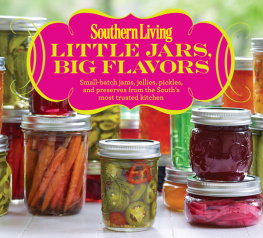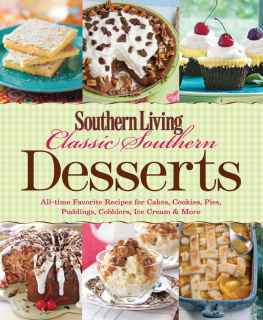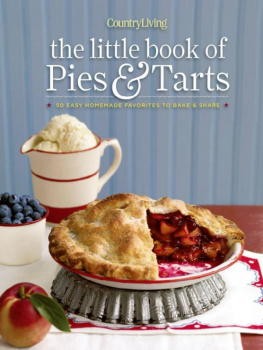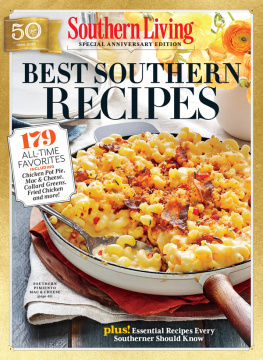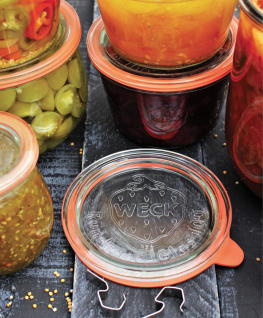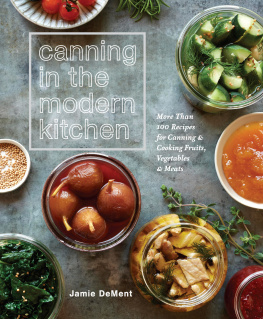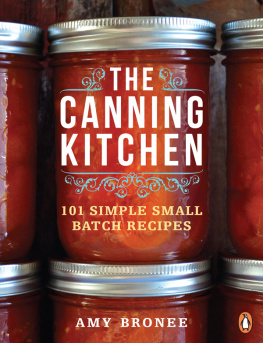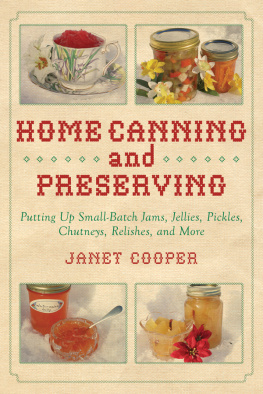
Southern Living
LITTLE JARS, BIG FLAVORS
Small-batch jams, jellies, pickles, and preserves from the Souths most trusted kitchen

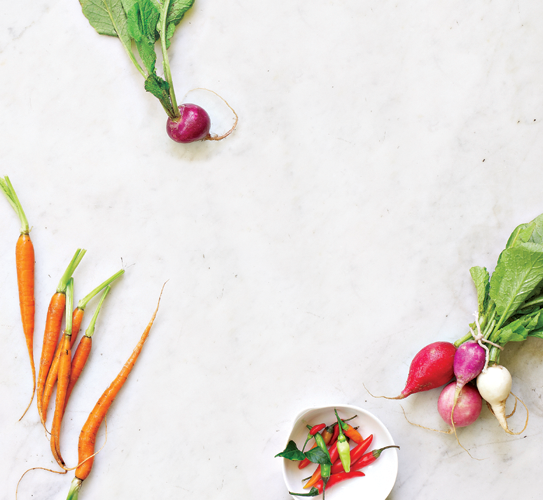

2013 by Time Home Entertainment Inc.
135 West 50th Street, New York, NY 10020
Southern Living is a registered trademark of Time Inc. Lifestyle Group. All rights reserved. No part of this book may be reproduced in any form or by any means without the prior written permission of the publisher, excepting brief quotations in connection with reviews written specifically for inclusion in magazines or newspapers, or limited excerpts strictly for personal use.
eISBN: 978-0-84875-389-4
Library of Congress Control Number: 2013930595
Printed in the United States of America
First Printing 2013
Oxmoor House
Editorial Director: Leah McLaughlin
Creative Director: Felicity Keane
Senior Brand Manager: Daniel Fagan
Senior Editor: Rebecca Brennan
Managing Editor: Rebecca Benton
Southern Living Little Jars, Big Flavors
Editor: Nichole Aksamit
Art Director: Claire Cormany
Project Editor: Emily Chappell
Senior Designer: Melissa Clark
Director, Test Kitchen: Elizabeth Tyler Austin
Assistant Directors, Test Kitchen: Julie Christopher, Julie Gunter
Recipe Developers and Testers: Wendy Ball, R.D.; Victoria E. Cox; Tamara Goldis; Stefanie Maloney; Callie Nash; Karen Rankin; Leah Van Deren
Recipe Editor: Alyson Moreland Haynes
Food Stylists: Margaret Monroe Dickey, Catherine Crowell Steele
Photography Director: Jim Bathie
Senior Photographer: Hlne Dujardin
Senior Photo Stylist: Kay E. Clarke
Photo Stylist: Mindi Shapiro Levine
Assistant Photo Stylist: Mary Louise Menendez
Senior Production Manager: Susan Chodakiewicz Production Manager: Theresa Beste-Farley
Contributors
Writer: Virginia Willis
Designer: Cathy Robbins
Recipe Developers and Testers: Tonya Johnson, Kyra Moncrief
Copy Editor: Donna Baldone
Proofreaders: Dolores Hydock, Rhonda Lee Lother
Indexer: Mary Ann Laurens
Interns: Morgan Bolling, Susan Kemp, Sara Lyon, Staley McIlwain,
Emily Robinson, Maria Sanders, Katie Strasser
Food Stylist: Kathleen Royal Phillips
Photographers: Becky Luigart-Stayner, Ellen Silverman, Daniel Taylor
Photo Stylist: Lydia DeGaris Pursell
Southern Living
Editor: M. Lindsay Bierman
Creative Director: Robert Perino
Managing Editor: Candace Higginbotham
Art Director: Chris Hoke
Executive Editors: Rachel Hardage Barrett, Hunter Lewis, Jessica S. Thuston
Food Director: Shannon Sliter Satterwhite
Test Kitchen Director: Rebecca Kracke Gordon
Senior Writer: Donna Florio
Senior Food Editor: Mary Allen Perry
Recipe Editor: JoAnn Weatherly
Assistant Recipe Editor: Ashley Arthur
Test Kitchen Specialist/Food Styling: Vanessa McNeil Rocchio
Test Kitchen Professionals: Norman King, Pam Lolley, Angela Sellers
Senior Photographers: Ralph Lee Anderson, Gary Clark, Art Meripol
Photographers: Robbie Caponetto, Laurey W. Glenn
Photo Research Coordinator: Ginny P. Allen
Senior Photo Stylist: Buffy Hargett
Editorial Assistant: Pat York
Time Home Entertainment Inc.
Publisher: Jim Childs
VP, Strategy & Business Development: Steven Sandonato
Executive Director, Marketing Services: Carol Pittard
Executive Director, Retail & Special Sales: Tom Mifsud
Director, Bookazine Development & Marketing: Laura Adam
Executive Publishing Director: Joy Butts
Associate Publishing Director: Megan Pearlman
Finance Director: Glenn Buonocore
Associate General Counsel: Helen Wan
CANNING BASICS
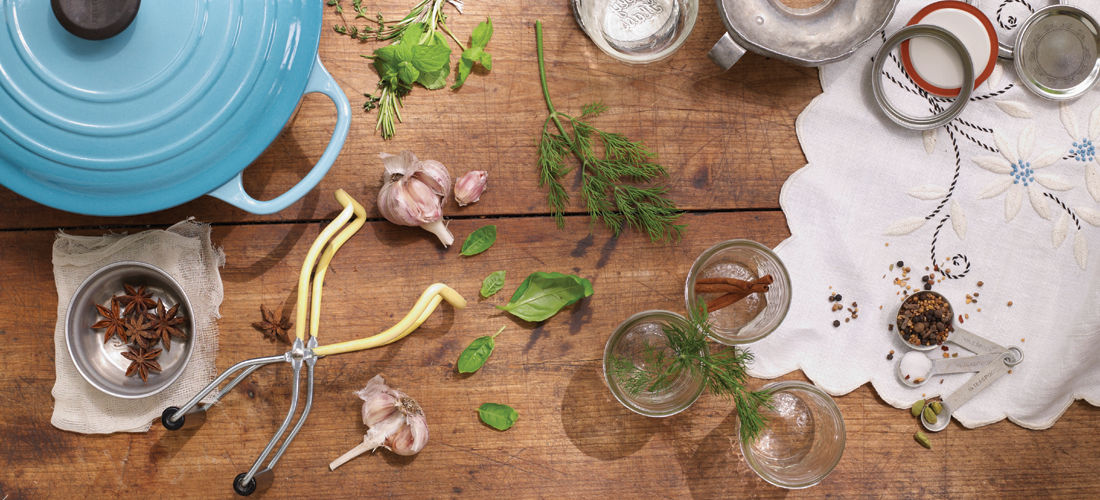
A SHORT HISTORY OF HOME CANNING

Whether youre new to canning or an old hand at putting up, its comforting to know that people have been preserving food for millennia.
Long before there were glass jars to pack them in, there were pickled foods and potted jams. The term canning dates back to the military practice of putting food in tin canisters or cans, the method that kept Napoleons French soldiers fed in the early 1800s.
Glass jars werent widely used in the United States for home food preservation until after the Civil War. Early American cooks preserved foods mostly by smoking or drying themor by putting them in crocks with salt, vinegar, sugar, or alcohol solutions; keeping them in the root cellar; periodically scraping off surface molds and scum; and taking their chances.
Self-sealing heatproof Mason jars, named for the fellow who invented them, were developed in the 1850s, and early attempts at canning in them yielded more than a few exploding jars, food poisonings, and deaths. It wasnt until 1915 that scientists identified what was causing botulism poisoning, and the U.S. Department of Agriculture began developing guidelines to keep the anaerobic bacteria from canned goods. Modern canning practicesusing heat, pressure, and acidity to kill or slow bacteriastem from this.
Newer revelations about canning include:
Those paraffin wax seals Grandma used on jams are a no-no. So is letting hot food cool in a hot jar to create a vacuum. Processing jars with canning lids in a covered pot of boiling water or a pressure canner for a specified length of time is essential.
The acid or pH level of tomatoes and other foods can vary considerably depending on ripeness, freshness, variety, and growing conditions. Recipes that worked fine in the 1950s might not work as well with modern varieties and changing climates.
Certain low-acid foods (meats, fish, most vegetables, ripe tomatoes, and some fruits) are most reliably and safely canned in a pressure canner. Alternatives include adding acid (vinegar or bottled lemon juice or citric acid powder) to the food before boiling-water canningor preparing it for refrigerator or freezer storage rather than for the shelf.
The density of the canned food (thin slices versus whole cucumbers) and the altitude where youre canning (11 feet above sea level in Mobile, Alabama, or 13,000 feet in Denver, Colorado) affect sterilization and processing time. The thicker the food and the higher the altitude, the longer youll have to boil.
A LITTLE FOOD SCIENCE

There are three primary ways to halt or stop the growth of harmful bacteria that naturally occur in food: Heat or chill them to extremes, deprive them of oxygen and free water, and add enough acid to keep them from growing.
All three come into play in canning. To what degree and in what combination depend largely on how acidic the food is.
Next page
